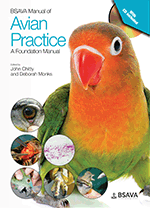
Full text loading...

A post-mortem examination is an extremely important part of the service a veterinarian can offer to wildlife carers, aviculturists and pet bird owners. A thorough post-mortem examination will often provide more information than diagnostic procedures performed on the live bird, and is an invaluable learning experience for those new to avian medicine.
Post-mortem examination, Page 1 of 1
< Previous page | Next page > /docserver/preview/fulltext/10.22233/9781910443323/9781910443323.14-1.gif

Full text loading...
























